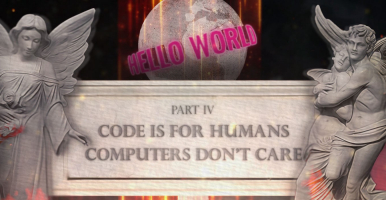Do what I mean, not what I say!
Leadership through mind reading — a practical guideWhen you say something, how does it actually sound in the other person’s head? We cannot know, right? Sometimes it is a real mystery.
Think about politics, you say something completely harmless (ot so you think) and suddenly the party is over. What happened? You cannot ask the other person because what they say seems to pass through the same strange filter on the way back.
Wouldn’t it be great if we actually understood what was in their mind?
Let’s face it, communication is HARD! Getting a message across without being distorted is almost impossible. Even if you seem to be in 100% agreement the actions can prove otherwise.
One fundamental problem is that words mean different things for everyone. It’s a matter of semantics!
Experience also plays in, if you are a junior then there is probably a shitload that you don’t know (we are all juniors in some sense).
And more than anything, our beliefs which makes our brain override all logical thinking without we even noticing it.
It is a mess! So if you need to get something across, is it hopeless? Well, we cannot stop trying if we don’t want to live in a hole the rest of our lives. And if we work with leading others in doing amazing work then we just have to solve it!

The Art of Information Transfer
Information Transfer. Yeah I know, it sounds super boring, but as usual I find the most boring topics immensely fascinating! So what is Information Transfer?
The transfer of information and knowledge from one human being to another.
I am sure you are as excited as I am to dig deeper 😜.
The value of mastering information transfer is massive! Think about a task that required someone to dive deep into research and prototyping that finally led to something ground breaking. This knowledge and experience is now confined in a single person. If there are methods for information transfer in place then this knowledge is not limited to a single person, but to a whole team or a company. No more inventing the wheel!
Information transfer is a huge topic. It covers communication, processes, tools and more. In this article I will focus on communication in general.
Communication channels
There are many channels we can use for the information transfer, talking, chatting, mailing, documentation. I have covered the efficiency of some ot these channels, or rather lack thereof, in an earlier article.
Regardless of channel we can use two different approaches to the communication: Push Communication and Pull Communication.
Push Communication
You have a task that someone else needs to do. It is serious stuff so you want to get it down in writing. You put lots of effort to explain all the details and make everything super clear. After some (or more likely many) rounds back and forth the other person seems to understand everything. Ok, let’s do it!
It is not until the work is done that you realize that there is always one more way that your words can be misundertood or one more piece of information that you forgot to transfer. And one more. And one more.
The totally misguided solution is to become even more specific, to write longer and longer emails dissecting every little detail, as if more words are the solution to the problem.
The more you try to explain the more questions there will be
The fundamental problem is that we are not mind readers. We don’t know what is complicated or hard to understand for the other person. We are just guessing what we need to say to make them understand. And since communication is HARD to begin with the probability of getting on the same page is minimal.
Emails with very detailed instructions are not only very time consuming to write, they are also killing all creativity for the receiver. They will focus on trying to understand what you want them to do instead of thinking about the best way to solve the problem.

So just focus on the end result then?
To solve that we could leave the solution to the receiver and just focus on what needs to be achieved. That minimizes the amount of information that needs to be transferred and the receiver gets the freedom to use their expertise to solve it in the best way. If this is an option, then just go for it.
Sometimes it is not that simple. Here are some examples:
- the problem can be solved in several ways, by themselves equally good. But only one of the solutions will support a later stage feature, or make it re-usable in another project, something that the receiver isn’t aware of.
- the selected solution will affect other parts in the project, so it cannot be chosen independently. E.g. a technical solution affects an marketing opportunity.
These are dependencies outside the current task that should affect the selection of solution. The only way to solve this using Push Communication is to give the full picture to the receiver so that they can make an informed decision.
This leads to even longer emails which can be misunderstood in an even larger number of ways. And in big projects it is completely impossible to give the full picture to everyone involved.
To summarize the problem
There are many parts in a project, each one affects the others in more or less obvious ways. If the receiver is to make the decision they need to see the bigger picture. To have everyone see and understand the bigger picture is not feasible.
Pull Communication to the rescue
It is pretty simple actually.
Focus on the end result and let the other person explain how they are going to solve it.
The first part is to describe the task in broad terms, what the result should be and if there are any obvious dependencies. Don’t even try to make it sound complete, we want the other person to ask questions, and if it feels like you have everything figured out they won’t.
When they ask questions we understand what they know, understand, and how they interpret the task. This allows us to guide them in their understanding while getting feedback on the progress.
When you are sure that all necessary questions are asked and answered then we can move on to the solutions.
Ask them to suggest a solution or approach they would like to take. The first round should not go deep but be based on their intuitive understanding. This allows us to verify that they are looking in a direction that will be in line with the bigger picture before spending too much time on it.
If it makes sense, ask them to write a specification. It doesn’t have to be a novel as long as it covers everything that matters. A time estimate is essential since this will give an understanding of what the person thinks is complicated and what is not. And if the best solution takes three weeks and the second best ten minutes, then I am sure you want to know that before deciding 🙂.
If the solution isn’t in line with the bigger picture, explain where you think it might create problems, see if the solution can be tweaked or if another route is needed. Then write the specification as described above.

The benefits
There are so many benefits with this method that my brain almost explodes but here we go:
- we know what the other person thinks, what they know, how we can support them. Mind reading!!
- we know that the solution will not only solve the problem, it will also deliver value in the larger context.
- it creates an ownership of the task, they have defined the task, invested time into it, and will eventually get credit for the solution.
- it uses the full creativity and expertise of the receiver. They can probably come up with solutions that you never could have imagined.
- it minimizes the need for information transfer.
- it allows the person to become as involved as they like in the bigger picture. They will lead this through their questions and passion.
- it works both for juniors and experts, about topics that you know in your sleep and where you are clueless.
I could probably go on for a while more but I don’t want to oversell 😜.
Mind reading is not only for leaders
This method is applicable for all leading roles, be it management, creative, production, technical. But it isn’t really limited to that. It can be used in many situations where you need someone’s help to solve a problem, of course in a much less formal way!
Invite someone to solve a problem together with you and lead and support them through the process. It might not work for all cases and problems, but as a general approach I think it is always superior to the pushy way.
Let me know what you think!





